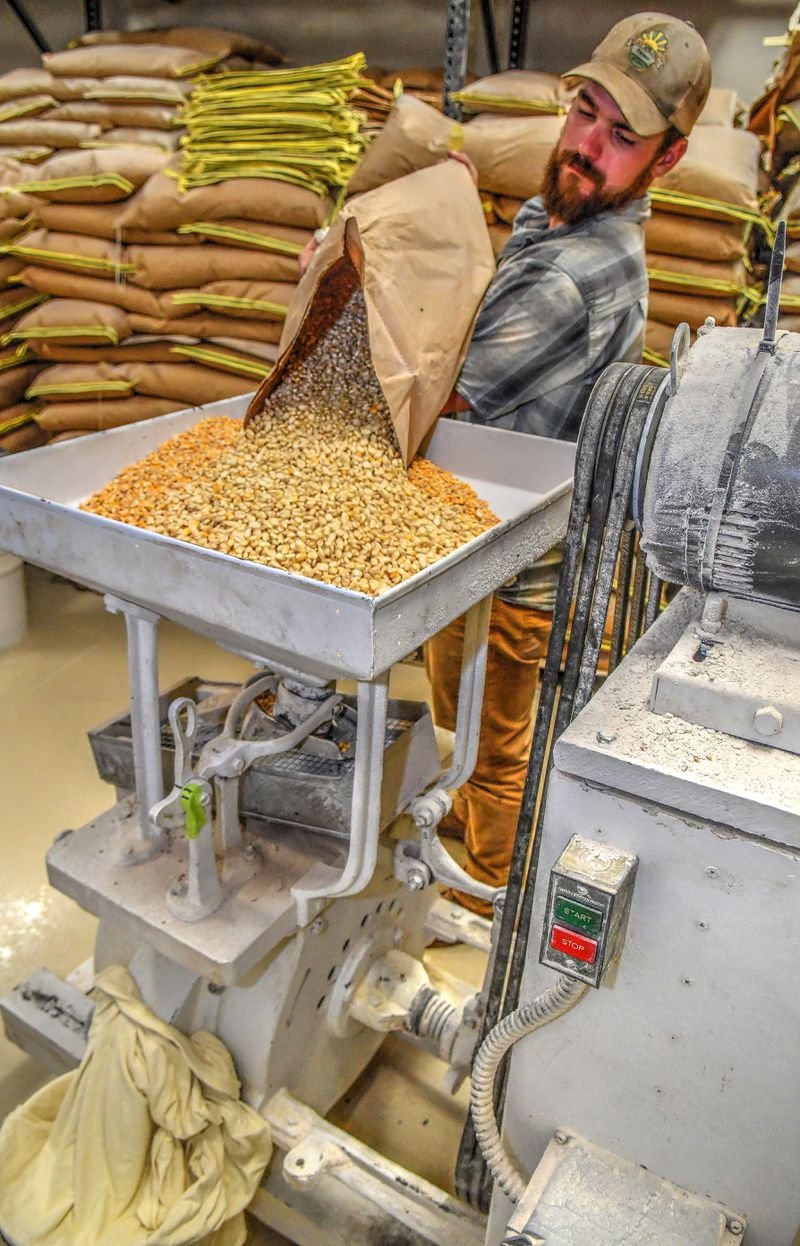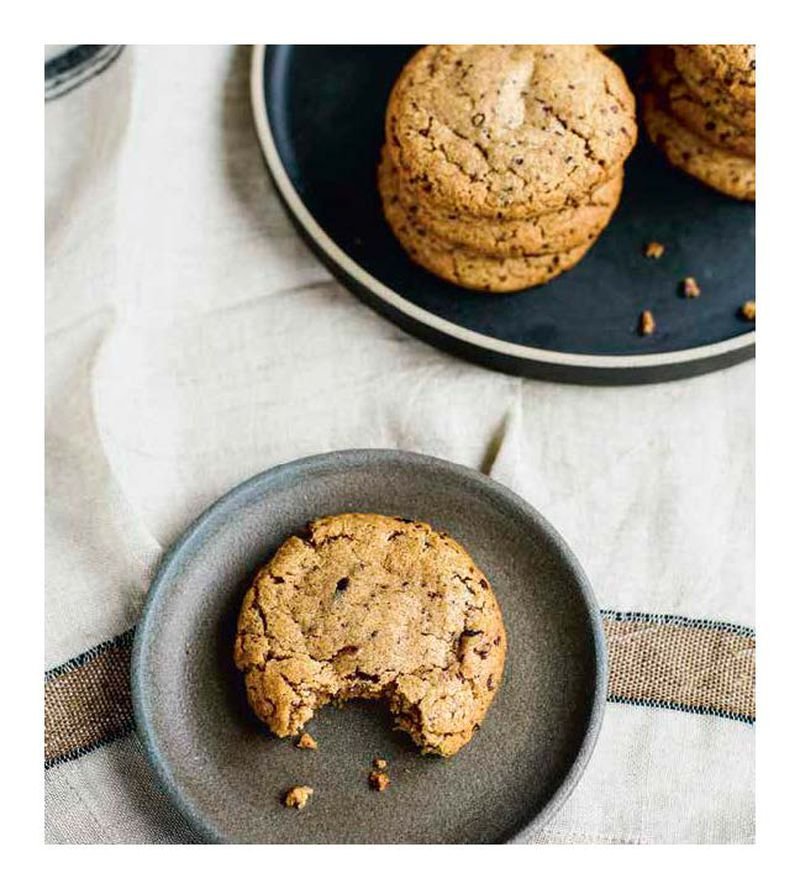The Atlanta Journal-Constitution: Regional grain is having a moment
Regional grain is having a moment
By Ligaya Figueras, The Atlanta Journal-Constitution
If you’ve purchased sourdough bread from Root Baking Co., English muffins from the Chastain, bagels from Dear Friend Bagels or cookies from the Little Tart Bakeshop, count yourself as part of the resurgence of freshly milled flours made from regionally grown grains.
Jennifer Lapidus, principal and founder of Carolina Ground, a mill located just outside of Asheville, North Carolina, captures this moment for flour power in her recently released book, “Southern Ground: Reclaiming Flavor Through Stone-Milled Flour.”
Lapidus is a baker turned miller whose passion for baking bread began while she was in college in the early 1990s. It became enough of an obsession that she nixed a future in the field of law for an apprenticeship with the late Alan Scott, who is credited with reviving the tradition of baking naturally leavened whole-grain breads in wood-fired brick ovens. Those lessons in old-world bread-making led her to launch Natural Bridge Bakery in Asheville in 1994.
“I started baking, because nobody was doing real bread,” she said. “I thought about the idea of bread as the staff of life, and didn’t feel that the bread being sold in the store was coming close to that concept.”
What set her product apart, besides the wood-fired oven and naturally leavened end product, is that she milled the whole-grain flours (bread wheat, rye, spelt and more) herself, ordering most of it from a mill in Minnesota. “There wasn’t anybody growing it here in the South,” she said.
Hard wheat is the type of wheat used in bread-making, but most of that is grown in the Midwest. The possibility of growing hard wheat in the Southeastern U.S. finally became a reality in 2008, when a bread wheat variety that could withstand the rainfall and humidity of this region became available.
The release of this breed of wheat happened to coincide with an economic crisis that saw the price of wheat increase as much as 130%, Lapidus said. She and other area bakers saw it as an opportunity to launch a community mill that connected North Carolina farmers with bakers, thereby creating a market for growing grain for human consumption in the region.
“We envisioned a mill centered upon the idea that place matters: a community mill connecting farmer, miller and baker, one that was environmentally and economically sustainable, decreasing food miles, and stabilizing pricing,” Lapidus explains in “Southern Ground.”
She wrote a grant proposal that received funding in 2009. By 2012, Carolina Ground shifted from a nonprofit entity to a for-profit business that since has become a leading source for bakers in search of regionally grown, stone-milled flours.
“It’s especially exciting for me,” Lapidus said, “because I’ve seen it even when I was selling at farmers markets, when farmers markets were a fringe thing. To see so much of this take hold is incredibly exciting.”
In the book, Lapidus profiles dozens of bakers in the South who are passionate about using local, stone-milled grains, including Atlanta bakers Betsy Gonzales of microbakery Osono Bread, Emma Schacke of Evergreen Butcher + Baker in Kirkwood and Sarah O’Brien of Little Tart, which has locations in Grant Park, Summerhill and at Krog Street Market.
“To decide to be a baker, you’re driven by something more than making money,” Lapidus said. “For me, as a baker over 25 years ago, I was like, ‘I’m going to mill my flour fresh, do natural leavening, a wood-fired oven.’ There are easier ways, but I was driven by making this bread in a way that needed to be out in the world.”
O’Brien, who purchases most of her local and regional flour from Carolina Ground, has a similar mindset. “With every ingredient, we try to figure out where we can find it closest to us, and the best quality,” she said. “I think that has attracted people to us from the beginning. People expect it of us. It’s part of our ethos.”
Just as Lapidus milled on-site during her baking days with Natural Bridge Bakery, so, too, does Chris Wilkins of Root Baking Co. and Pizza Jeans. It’s a practice he began when Root was still in Charleston, instead of Ponce City Market in Midtown Atlanta.
Wilkins sources his whole grains from numerous farms from around the country. Plenty of those purveyors are farms in the Southeast, including 10-year-old DaySpring Farms, an organic farm and milling operation in Madison County, run by father-and-son Murray and Nathan Brett.
Last year, Wilkins prodded the Bretts to plant a few acres of a unique heritage French grain, called rouge de Bordeaux. This year’s results, Wilkins said, have been stupendous. “It’s one of their best crops ever, which is good, because I kind of felt responsible.”
Developing a relationship of trust between farmer, miller and baker is key in order for the production of regional, artisanal grain to continue in a positive trajectory, Lapidus noted.
“When we first started working with growers, they were growing soft wheat for the feed market,” she said. “I was coming to them and saying, ‘Hey, we have these varieties for bread wheat. We want this to be food-grade and market you as geographically distinct.’ Part of the conversation going from feed-grade to food-grade is: It might be less yield, but we’ll pay you. It’s taken us a long time to develop relationships, so it doesn’t put all the risk on the grower.”
Besides commercial bakers, home cooks are making it feasible these days for farmers in the Southeast to grow specialized grains. Like DaySpring Farms and other small-scale mills around the country, Carolina Ground experienced an enormous uptick in online retail business during the pandemic, when home cooks scrambled to find flour, because grocery shelves were bare.
“The home baker is, in a way, subsidizing to make the system work,” Lapidus said.
The 80 recipes in her book are written with the average home cook in mind. A scale, a mixing bowl, maybe a Dutch oven for hearth breads, and there’s not much else you need. “Baking shouldn’t be intimidating. Just step in and engage,” Lapidus said, encouraging would-be bakers.
Lapidus told the story of a blind woman who found success with sourdough baking during the pandemic. “Eyesight is probably our biggest crutch in baking,” she said. “Taking away sight, and engaging with the sense of touch, smell and taste, is going to bring us up a few notches as bakers at home — and, if you’re using good flour, it should be better.”
Salted Peanut Butter Cookies with Cacao Nibs
Among the regional bakers featured in “Southern Ground” by Jennifer Lapidus is Sarah O’Brien, owner of the Little Tart Bakeshop. “I love that Sarah O’Brien chose spelt for this cookie,” Lapidus writes in the book. “Spelt’s nuttiness and tender crumb further accentuate the creamy peanut butter. The cacao nibs act as the staccato, pronounced though without drowning out the other flavors. It is a perfect balance of flavor, texture and mouthfeel.”
RECIPE
275 grams (1¼ cups) unsalted European-style butter, cut into tablespoon-size cubes
200 grams (1 cup) light brown sugar
170 grams (¾ cup + 2 tablespoons) granulated sugar
226.5 grams (2 cups) whole-spelt flour
1 tablespoon fine sea salt
1 teaspoon baking soda
2 eggs, at room temperature
400 grams (1½ cups) creamy peanut butter
1¾ teaspoons pure vanilla extract
150 grams (1¼ cups) cacao nibs
In the bowl of a stand mixer fitted with the paddle attachment, combine the butter and both sugars and beat on low speed for about 20 minutes, until fluffy, stopping to scrape down the sides of the bowl several times during mixing.
Meanwhile, into a medium bowl, sift together the flour, salt and baking soda.
Add the eggs to the butter mixture, beating until well incorporated, and scraping down the sides occasionally. Add the peanut butter and vanilla, and mix thoroughly. (Be sure to scrape the bottom of the bowl thoroughly at this step.)
Add the flour mixture, and mix until almost incorporated. Scrape down the sides. Add the cacao nibs, and pulse just until they are incorporated. Transfer the dough to an airtight container and refrigerate for at least 3 hours, or, ideally, overnight.
Line a baking sheet with parchment paper. Using a 1-ounce scoop, or a heaping tablespoon, scoop the dough onto the prepared baking sheet. Cover with plastic wrap and place in the freezer for at least 2 hours.
Preheat the oven to 325 degrees.
Uncover the pan and bake the cookies directly from the freezer for 7 minutes, then rotate the pan and bake for another 7 minutes, or until the edges are lightly browned and the centers are set, but still soft. Transfer to a cooling rack.
Once fully cooled, these can be stored in an airtight container at room temperature for at least a week, though they will not last that long. Makes 45 cookies.
Nutritional information
Per serving:Per cookie: 168 calories (percent of calories from fat, 67), 3 grams protein, 11 grams carbohydrates, 2 grams fiber, 13 grams total fat (6 grams saturated), 22 milligrams cholesterol, 203 milligrams sodium.
Lemon Pound Cake
Emma Schacke, co-owner with husband Sean Schacke of Evergreen Butcher + Baker in Kirkwood, is among Carolina Ground clientele featured in Jennifer Lapidus’ “Southern Ground.” Lapidus praises their lemon pound cake for its moistness, delicate crumb and silky mouthfeel.
RECIPE
For the cake:
280 grams (2⅔ cups) finely sifted stone-ground cake flour
2 teaspoons baking powder
6 eggs, at room temperature
400 grams (2 cups) granulated sugar
lemon zest from 4 lemons
¾ teaspoon fine sea salt
160 grams (⅔ cup) heavy cream
180 grams (¾ cup + 1 tablespoon) unsalted butter, melted and cooled
For the glaze:
250 grams (2 cups) confectioners sugar
60 grams (¼ cup) fresh lemon juice
Heat the oven to 325 degrees. Butter a 13-by-4-inch loaf pan and dust with flour, then tap out any excess.
Into a medium bowl, sift together the flour and baking powder.
In the bowl of a stand mixer fitted with the paddle attachment, combine the eggs, sugar, lemon zest and salt, and mix on medium speed for 1 minute. Alternately add the cream and the flour mixture, mixing until just combined after each addition, and stopping to scrape down the sides of the bowl as needed. Stir in the melted butter. Pour the batter into the prepared pan.
Bake until the cake is pulling away from the pan and a toothpick inserted into the middle comes out clean, about 45 minutes.
Meanwhile, make the glaze: In a medium bowl, stir together the confectioners sugar and lemon juice.
Remove the pan from the oven and let the cake cool in the pan briefly, before removing it from the pan. While the cake is still warm, brush it with the glaze. Allow the glaze to set before serving.
Store in an airtight container at room temperature for a couple of days, or up to a week in the refrigerator. Serves 12
Nutritional information
Per serving: Per serving: 509 calories (percent of calories from fat, 35), 6 grams protein, 78 grams carbohydrates, 1 gram fiber, 20 grams total fat (12 grams saturated), 141 milligrams cholesterol, 223 milligrams sodium.
Recipes reprinted with permission from “Southern Ground” by Jennifer Lapidus (Ten Speed Press).








